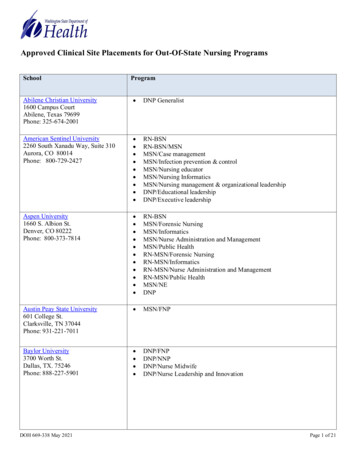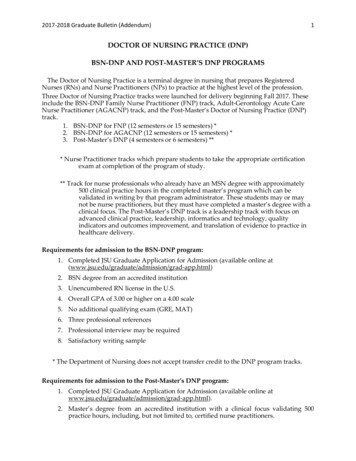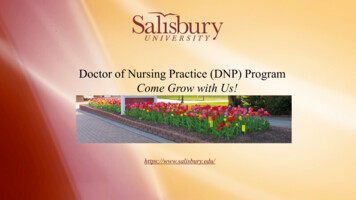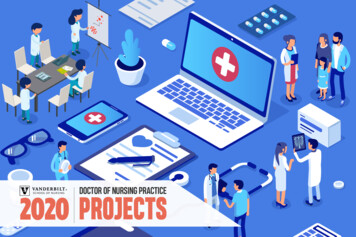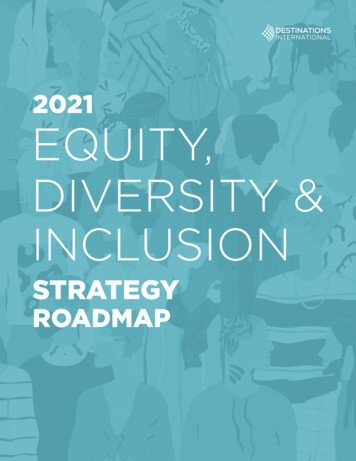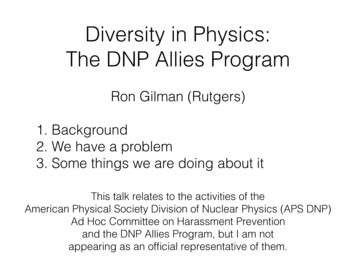
Transcription
Diversity in Physics:The DNP Allies ProgramRon Gilman (Rutgers)1. Background2. We have a problem3. Some things we are doing about itThis talk relates to the activities of theAmerican Physical Society Division of Nuclear Physics (APS DNP)Ad Hoc Committee on Harassment Preventionand the DNP Allies Program, but I am notappearing as an official representative of them.
BackgroundAPS statements, in ndex.cfm#ethicsStatement 19.1 Guidelines on EthicsAs citizens of the global community of science, physicists shareresponsibility for its welfare. The success of the scientific enterpriserests upon two ethical pillars. The first of them is the obligation to tellthe truth, which includes avoiding fabrication, falsification, andplagiarism. The second is the obligation to treat people well, whichprohibits abuse of power, encourages fair and respectfulrelationships with colleagues, subordinates, and students, andeschews bias, whether implicit or explicit. Professional integrity in theconception, conduct, and communication of physics activitiesreflects not only on the reputations of individual physicists and theirorganizations, but also on the image and credibility of the physicsprofession in the eyes of scientific colleagues, government, and thepublic. Physicists must adopt high standards of ethical behavior, andtransmit improving practices with enthusiasm to future generations.
BackgroundStatement 88.1 Promoting an Inclusive WorkplaceThe Council of the American Physical Society has long beenconcerned with the serious underrepresentation of women andminorities in the profession of physics and, over the years, hasestablished a number of programs that attempt to counter thistrend. The Council now urges each member of the Society to helpin this effort by being sensitive to all matters that affect theatmosphere of the physics workplace.In particular, actions that create a hostile, intimidating, or offensivework environment for any group undermine the affirmative actionefforts of the Society and should be eliminated. These actionsinclude the public posting and viewing of materials that areinsulting, derogatory, or exclusionary to a particular group.We call upon all members of the Society to help ensure thatpersons of every race, gender, and ethnic origin may feel awelcome part of the physics community.
BackgroundStatement 94.3 Policy on Equal Professional OpportunityThe APS, to achieve its goal of advancement and diffusion of theknowledge of physics, affirms a policy of equal opportunity for allSociety members. This policy requires that the Society and itsmembers conduct their professional activities without discriminationor harassment in regard to personal factors irrelevant to thepurposes of the Society including (but not limited to) gender, race,national origin, age, religion, marital status, political views, sexualorientation, or disability. Because respect for individuals is integralto achieving this goal, it is the policy of the APS that harassment ofcolleagues and co-workers in the professional environment,including sexual or racial harassment, is unacceptable behavior. We therefore reaffirm the Society's long-standing commitment toremoving barriers impeding the entry of women and minorities tothe career of physics, and to fostering their full-fledgedparticipation in our profession.
BackgroundStatement 00.4 Protection Against DiscriminationThe Council of the American Physical Society affirms thecommitment of the Society to the protection of the rights of allpeople, including freedom from discrimination based on race,gender, ethnic origin, religion or sexual orientation. This principlewill guide the Society in the conduct of its affairs, including theselection of sites of meetings of the APS.
BackgroundStatement 08.2 Diversity StatementTo ensure a productive future for science and technology in theUnited States, we must make physics more inclusive. The health ofphysics requires talent from the broadest demographic pool.Underrepresented groups constitute a largely untapped intellectualresource and a growing segment of the U.S. population.Therefore, APS members should work to increase the numbers ofmembers from underrepresented groups in physics in the pipelineand in all professional ranks, with becoming aware of barriers toimplementing this change, and with taking an active role inorganizational and institutional efforts to bring about such change.Such barriers include: a lack of effective mentoring, all forms ofbias (implicit/unconscious, explicit and systemic), a lack ofinstitutional support mechanisms, and an employment searchprocess with a limited candidate pool.
BackgroundStatement 15.2 Statement on the Status of Women in PhysicsThe American Physical Society (APS) believes full participation byeveryone, regardless of gender, is important to the health and futureachievements of our discipline. The number of women in physicsremains disappointingly low, and biases persist. The APS urges itsmembers, physics leaders and policy makers to take action to improvethe recruitment, retention and treatment of women in physics at alllevels of education and employment.Context and ActionsEnabling the full participation of women in physics requires improvinghow all physicists are treated, with particular attention to practices andassumptions that discourage women from joining and remaining in theprofession. Well‐intended efforts can fall short due to unintended andunconscious biases. The APS encourages leaders in industry,government, and academia to adopt, monitor, and refine systemicpolicies and practices that improve the recruitment, retention andtreatment of women.
BackgroundStatement 15.2 Statement on the Status of Women in PhysicsThe American Physical Society (APS) believes full participation bysteveryone, regardless of gender, is important toethen health and futuremachievements of our discipline. The numberof women in physicsetyatremains disappointingly low, and biasespersist.The APS urges itsdsayern?lmembers, physics leaders and policymakersto takeaction to improveraaeilmsrthe recruitment, retention andof womenin physics at allotreatmentamseelesblevels of educationandemployment.rvoara pehye 30Context and Actions wemao sddof women in physics requires improvingEnabling the fullparticipationeyehhiz with particular attention to practices andnhow all physicistsW onaret treated,gocassumptions that discouragewomen from joining and remaining in theerprofession. Well‐intended efforts can fall short due to unintended andunconscious biases. The APS encourages leaders in industry,government, and academia to adopt, monitor, and refine systemicpolicies and practices that improve the recruitment, retention andtreatment of women.
mnelebmoropwfaoe.nvsoa aticihso cip hyte rtipun pa s initn/eoitycitriesoW iver minddhntiaw
Section 2a:We have a problem.A?melborptne tmisnsear seah ot/y entisvraehviId
Who are these peopleand what do they have in common?Julie HermanMike RiceJack NelsonAlexandre PussieldiChuck WielgusWilliam StrampelHans Hermann GroërJack SchaapTimur Dykes
Who are these peopleand what do they have in common?Jerry SanduskyHarvey WeinsteinLarry NasserKevin SpaceyAl FrankenGeorge TakeiDonald TrumpTravis KalanickBill ClintonJeffrey EpsteinJoe BidenAlexander AcostaRoger AilesJung Joon-YoungBill O’ReillySeungriLes Moonves
Who are these peopleand what do they have in common?Allegations of behavior ranging from unwelcome to criminal:Julie Herman: volleyball coach, Rutgers AD “ no video, trust me”Mike Rice: Rutgers basketball coachJack Nelson: swim coachAlexandre Pussieldi: swim coachChuck Wielgus: head of USA swimmingWilliam Strampel: MSU dean who oversaw Larry NassarHans Hermann Groër: Archbishop of ViennaJack Schaap: Baptist pastorTimur Dykes: Boy Scout troop leader
88.1: We call upon all members of the Society to help ensurethat persons of every race, gender, and ethnic origin may feela welcome part of the physics community.from NPRAs a group, surgeons are not well known for their bedside manner. "Thestereotype of the abrasive, technically gifted . surgeon is ubiquitousamong members of the public and the medical profession," write theauthors of a 2018 article in the AMA Journal of Ethics. While poormanners aren't commonly accepted in most professional circles,representations of surgeons in popular culture often link technical prowesswith rude behavior, and some surgeons have even argued that insensitivitycan be helpful in such an emotionally strenuous profession.
from NPRAs a group, surgeons are not well known for their bedside manner. "Thestereotype of the abrasive, technically gifted . surgeon is ubiquitousamong members of the public and the medical profession," write theauthors of a 2018 article in the AMA Journal of Ethics. While poormanners aren't commonly accepted in most professional circles,representations of surgeons in popular culture often link technical prowesswith rude behavior, and some surgeons have even argued that insensitivitycan be helpful in such an emotionally strenuous profession.
Section 2b:We have a problem.mleb.oraipmaes adahcad l/trioe encwneeesihttc,soetnroueS ut n avBIh
Section 2b:We have a problem.Science, 14 June 2019
Section 2b:We have a problem.Science, 12 June 2019Science, 7 June 2019Science, 19 April 2019
Section 2b:We have a problem.
Section 2b:We have a problem.Science, 12 April 2019 Science, 11 January 2018
Section 2b:We have a problem.melb.oraipma desa cahad! l/triSo ce enCIwnSeeeYsihttcH,soPetnrTouenOvS utNahTBIUB,K.O hhhUh
Section 3:Some things we are doing about it
Section 3:Some things we are doing about itWho are we?DNP Ad Hoc Committee on Harassment Prevention:Ron Gilman (Rutgers University),Robert Janssens (University of North Carolina at Chapel Hill),Chair: Filomena Nunes (Michigan State University),Roxanne Springer (Duke University),Warren Rogers (Indiana Wesleyan University), andSherry Yennello (Texas A&M University).Three activities you might have noticed:Pushed APS on “code of conduct”APS News back page articleGetting DNP Allies Program started (DNP 2017 - 2018)
Section 3:Some things we are doing about itAPS Meeting Code of conduct.cfmIt is the policy of the American Physical Society (APS) that allparticipants, including attendees, vendors, APS staff, volunteers,and all other stakeholders at APS meetings will conduct themselvesin a professional manner that is welcoming to all participants andfree from any form of discrimination, harassment, or retaliation.Participants will treat each other with respect and consideration tocreate a collegial, inclusive, and professional environment at APSMeetings. Creating a supportive environment to enable scientificdiscourse at APS meetings is the responsibility of all participants.
Section 3:Some things we are doing about itAPS Meeting Code of conduct.cfmParticipants will avoid any inappropriate actions or statementsbased on individual characteristics such as age, race, ethnicity,sexual orientation, gender identity, gender expression, maritalstatus, nationality, political affiliation, ability status, educationalbackground, or any other characteristic protected by law.Disruptive or harassing behavior of any kind will not be tolerated.Harassment includes but is not limited to inappropriate orintimidating behavior and language, unwelcome jokes orcomments, unwanted touching or attention, offensive images,photography without permission, and stalking.
Section 3:Some things we are doing about itAPS Meeting Code of conduct.cfmViolations of this code of conduct policy should be reported tomeeting organizers, APS staff, or the APS Director of Meetings.Sanctions may range from verbal warning, to ejection from themeeting without refund, to notifying appropriate authorities.Retaliation for complaints of inappropriate conduct will not betolerated. If a participant observes inappropriate comments oractions and personal intervention seems appropriate and safe,they should be considerate of all parties before intervening.
APS News, April 2019The Back 4/backpage.cfm.htmlImpressions from the APS Division of Nuclear Physics FallMeetingBy Sara JaneNote:The APS Division of Nuclear Physics (DNP) is committed toproviding an inclusive space where physicists can exchangeideas and share their interests in nuclear physics, regardless ofthe origin, color, gender, sexual orientation, gender identity etc, ofthe scientist.In this context, last year the DNP requested stories from themembership. Rather than present each story in isolation, we havechosen to collect them as though they happened to one youngwoman as she navigates DNP meetings
APS News, April 2019The Back 4/backpage.cfm.htmlImpressions from the APS Division of Nuclear Physics FallMeeting16 diary entries:1 dangerous “joke”: “some days I just want to shoot all womenphysicists.”5 on issues with adviser: ignored2, put off for other student, troubled &couldn’t sleep, “affair” with adviser4 troubling “environment” comments: person ridiculed, opinionatedpolitics, complaint about women speakers, ignorance is bliss3 troubling personal verbal interactions: “thought I was a man”,anatomy, aggressive questions3 annoying individuals: ankle guy, pressure to dance, invitation to room
APS News, June s/201906/letters.cfmHarassment in PhysicsBlatant sexism in any professional area does expose an unhappydeficiency in the human condition. Although scientists are meremortals, we in the APS should expect a higher ethical standard fromour members. I can only hope that the small statistical samplepresented in the April 2019 Back Page feature is an aberration andnot the norm.As a Ph.D. student and through a long career as a nationallaboratory scientist, I personally saw many contrary and veryconstructive examples. Hopefully, subsequent articles will exposethe more positive interactions that current and future femalescientists had with their mentors.Robert G. Lanier, Danville, California
APS News, June s/201906/letters.cfmHarassment in PhysicsThank you for publishing the April 2019 Back Page article“Impressions from the DNP Fall Meeting.” I know APS could beconcerned about publishing these sorts of negative reports, but Ithink the benefit of articles like this is quite substantial. I’m not amember of DNP but I can easily imagine this sort of behaviorhappens at the APS meetings I attend; and I hope that raising theawareness of these issues will result in improvements over the longterm. So again, thank you for the courage to publish this.Eric Weeks, Atlanta, Georgia
DNP Allies Allies program is based on an effort begun in the astronomycommunity, to provide a “safe zone, resource, network, presence”,intending to avoid some perceived flaws of that program We are in addition a symbol of DNP’s interest in being a welcomingcommunity for all We started from the ad-hoc committee in 2017, expanded in 2018,and are working on expanding more for DNP 2019. It appears APS will be trying to start Allies programs in other areas. Allies Meet pre-DNP Planning, discussion including micro-aggressions, case studies,role playing
DNP AlliesCase Study example 1S approaches you at the conference and tells you that when shearrived at Waikoloa Village she was greeted by one of her malecolleagues who invited her to his room for drinks and gettingreacquainted. This is not the first time that he has made this kind ofoverture to her. She admits to you that at last year’s conference, shewent out for drinks with him, and they had a good time. She is in arelationship now, and is afraid that he will persist since he has thattendency based on their past interactions.
DNP AlliesCase Study 2Joe is a senior scholar well liked by most and respected for hisexperience and expertise. Some of the younger faculty and staffview him as a “father type” figure, something Joe appreciates. He describes himself as a “hugger” and routinely puts his armaround others, hugs them, and generally touches arms, hands etc.during conversations. Most people are fairly comfortable with Joe’sstyle. There are some who are somewhat uncomfortable; however,even most of them are willing to pass it off as “that’s just Joe.” Thereare several others who are very uncomfortable with Joe’s style,though they have never said anything to him or anyone else abouttheir level of discomfort. Instead, they have opted to limit theirinteractions with him in an effort to avoid any kind of physicaltouching.
DNP AlliesCase Study 2 Julie, a new graduate student immediately felt uncomfortable withJoe touching her during conversations. She confided in anotherwoman on the staff who said, “Oh don’t pay any attention to Joe, he’sharmless, that is just the way he is.” Julie continued to feeluncomfortable and without speaking directly to Joe, went to hergroup leader / building head with her concerns.
One final point I worked with Strom Thurmond all my life,’’ House Majority WhipJames Clyburn (D-S.C.), the highest-ranking African American inCongress, said of the infamous segregationist senator. You don’thave to agree with people to work with them.’’
One final point I worked with Strom Thurmond all my life,’’ House Majority WhipJames Clyburn (D-S.C.), the highest-ranking African American inCongress, said of the infamous segregationist senator. You don’thave to agree with people to work with them.’’I agree, in that APS policy encourages us to work with everyone, inparticular without bias to political views.I disagree, in the following sense: if we are to follow APS policy, Ithink it is our duty to not enable people who willfully create a hostileenvironment, violating their duty to have fair and respectfulrelationships.
The DNP Allies Program Ron Gilman (Rutgers) 1. Background 2. We have a problem 3. Some things we are doing about it This talk relates to the activities of the American Physical Society Division of Nuclear Physics (APS DNP) Ad Hoc Committee on Harassment Prevention and
